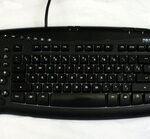How do I plan a successful Field Day? Tips, ideas, resources, etc?
-Ms. T.-
Dear Ms. T,
Planning a field day can be time consuming and very involved. However, if you create a good system for developing one, it can make the process more efficient. Therefore, I will layout below some key points to consider when planning your field day to help it go smoother.
Research
Before you put pen to paper or hands to a keyboard to start planning, do some research. This includes talking to your administration, former P.E. teacher, colleagues in the building, and other P.E. teachers. When researching, you are looking to find some key pieces of information.
When discussing field day with the administration in your building, you are trying to find out several things. Some of this information includes asking what was done before you worked there, what are some traditions of field day that you may want to keep, and what are some needs or considerations you may want to take into account when planning this year’s field day. In addition, you will want to find out any important procedural guidelines you may have to follow in your county for getting volunteers and other do’s and don’ts. The people in your building can help clarify this ahead of time so it makes your planning process more efficient.
The other aspect of researching your field day involves finding out what colleagues in your profession have done or are doing. This may help spark some ideas for you or allow you to talk out some of your thoughts in order to clarify your vision for your field day.
The last part of the research could include looking for some field day activities or themes in books or on websites. A couple of good references include the book Field Day Survival Guide or the website http://www.pecentral.org. Both of these resources have a tremendous amount of useful information.
Planning
As the famous quote goes, “failing to plan means planning to fail.” With field day, this is so true. You are going to need to plan, and plan as far in advance as you can. You will need time to get approval for things, arrange for materials, create materials, communicate with staff and students, prepare students, revise plans, etc. This takes time, and when you do this in a hurry, it can lead to problems. Below I try to provide a list of documents and other items you will need to create and what to do with them when. When planning, consider making backup plans for what to do if it starts to rain and you need to move inside, if it rained the night before and you can only use your blacktops or dry areas, and any other foreseeable scenarios. Remember to discuss all final plans with your administration and get their approval on any material sent home.
Packet Cover – This is a simple cover to a packet you will create that provides teachers and parents with information. It is best to make one packet for colleagues and one for parents. Each packet will include different information. You can customize what you put in each packet. For volunteers, I include the activities and stations sheet, schedule, and maps. For the teachers I add the t-shirt order form.
Letter to Parents/Volunteer Request Form – In this letter, you will inform the parents of your field day date, rain date, and attach a tear-off form asking for volunteers. In this letter you may include what volunteers may sign up for, the time allotment you will need them for, finger-printing information, and any other particulars that you may need to call immediate attention to that involve advanced planning or notice on behalf of the parents. In the tear-off form, make sure to get contact information so you can contact parents a week or so before the event to remind them about their assistance.
Letter to Teachers – In this letter you will specify the dates for field day and explain any pertinent information you want to make clear immediately. This could range from explaining your theme to detailing how you want students to be broken up for activities. It will vary based on what you’re planning.
Activities/Stations – In this document you will list all your activities. Include a description of each one, what equipment is needed, and a space to note which volunteers or staff will be at each activity. You will most likely want to order the activities by the station number and special name if you use a theme in order to keep it as simple as possible. This also means preparing specific instructions for how each activity is played. For example, if you have a parachute station, print out parachute games for the person running the station. This document will become very important as you share your plans with administrators, parents, and colleagues.
Equipment Needs – In this document, list your stations in order and call out any needs you will have that require administrative or custodial attention. This may include things such as bottled water for volunteers, chairs for each station for volunteers to sit out, or game equipment such as sponges for water relays. This document will help you articulate what you need for the event day so you are ready come that day.
Schedule – There are many ways to present your schedule. I prefer an excel spreadsheet. I have seen other methods. It is dependent on what makes you comfortable. This schedule is going to be the teacher’s best friend on field day. Make sure to include lunch times, bathroom break times, rotation order, and activity names that are consistent in what you used in your other documents.
Map – This is the teacher’s second best friend on field day. Just like children, adults process information differently. I make two maps. One is a verbal description of where each activity is. For example, “station one is to the left of the back door.” The second map is a very detailed layout of where everything is. I use words and draw objects. I make it colorful and make sure to note where landmarks such as sidewalks, trees, fences, courts, and other places so that there is no confusion as to where to go. I make it so it mimics what an architect’s design of things might look like. In addition, I would organize events in a simple circular fashion if you can so rotating goes smoothly. Place the water events near the hose so it makes refilling the water stations easy. Consider this map as a visual depiction of your master plan.
Reminder Slips – This is a simple slip of 3 x 5 inch paper that will get sent home with each student the day before, and the paper will state: field day is tomorrow; make sure that students dress in light, breathable clothes; wear hats and sunscreen, and the day starts at a certain time.”
Volunteers Reminder Letter – People are busy, and schedules change. So, this letter is very similar to your first parent letter you sent out. It still has a slip on it that new volunteers can send in. Send it out a few weeks before your field day. Also, in this letter you will want to add where volunteers go when they show up and if lunch is provided or not so they can plan ahead. You will be surprised how it helps. Again, emails and phone calls the week before will help too with getting firm commitments.
T-Shirt Order Forms/Collection Forms – If you are doing t-shirts for students and/or staff, you will need this form. On it should be a picture of the design for the shirt, color options, pricing and due date, hand out date, and collection instructions. The collection form is a separate form used as a way for you to capture the data from the order form. I use an excel spreadsheet with a title of each piece of data I asked for on the order form. From there you can make the items into lists that let you filter the information. Trust me, it helps when you go to place the order so you know how much of what size and color you need. It also will help when counting money to have this break down. Each county has its own money collection procedures, and you will need to be aware of those and follow them to the letter of the law.
Non Field Day Participants – Some students lose the privilege to participate in field day. That is a school-based decision. If this happens, I like to get an idea of which students are not participating. It helps me plan more efficiently.
Pre-Field Day Meeting Agenda/Notes – About a week before the event, plan a meeting with teachers. Discuss some of the key points of how the day will run, answer any questions, and hand out your informational packets. Make sure to have an agenda and sign in sheet for your records.
Volunteer Sign in Sheet – This is what it says. Your volunteers sign in on this sheet. Keep it and use for next year to recruit volunteers. Also, this should lets you know who is present and where they are stationed.
Station Signs – Having a very visible, large sign for each station will make the transitions between stations easier. This can be a project students help you with. I have seen some teachers put the schedule on the back of each sign or other information on the back of the signs.
Welcome Banner/Other Goodies – The aim here is to make the day seem more special. Have a nice welcome banner for all to see. You may choose to have balloons set up or someone go around blowing bubbles all day. Additionally, this may include making PA announcements leading up to the event or revealing one activity each day to the students. Spice it up and build an anticipatory crescendo.
Volunteer Space – Have a set aside room for volunteers to go and take a break or eat lunch. In it you may have a banner, a table set up with water and snacks, and chairs to sit in.
Certificates/Awards – Have these ready in advance with signatures on them so all you have to do is fill them in. I would have appreciation certificates for volunteers, awards for students, and maybe something to show appreciation for the staff.
Scoring Rubric/ Awards – Detail how teams will be assessed points for any awards you may give. This way, no one is second-guessing your decisions.
Website – I have a website where I put up some basic information including dates, times, activities, and a volunteer form that parents can submit. This may help make your communication more thorough and engaging.
Execution
So the day is finally here. You have planned and thought out every inch of your event, and you’re ready for it. You have communicated, and you have provided with as much information as possible so the day can run smoothly. So now what? Here are some additional thoughts:
Set up the night before if you can. This may mean laying out station signs and equipment by station in the gym so when you come in in the morning it’s all out and ready to get set up.
Get to school early enough to leave yourself time to set up and make any last minute arrangements.
Get help in advance from your custodial staff and willing teachers to help you set up.
Teachers and helpers are still going to have questions. Be available and open to answer questions.
Arrange for some exemplar students or safety patrols to help welcome the volunteers to the school, give them the information, and help show them to their station. This frees you up to take care of any loose ends.
I know this is a lot. However, there is no replacement for creating a solid structure for a big event like this. You will have this for the rest of your career to help you plan in the future. The time spent up front is worth the investment when you see how much the students are enjoying the day, and the parents and staff pay compliments instead of complaints. My last piece of advice is to have fun and enjoy the experience. I will always relish the water fights with the kids and the sheer enjoyment of my first-ever well planned day using the documents, techniques, tips, and resources I have provided above.
Email me at [email protected] with your question!



